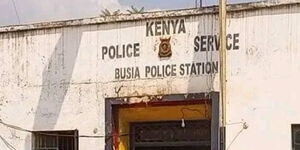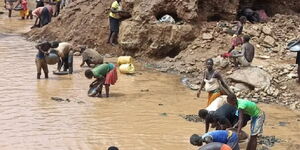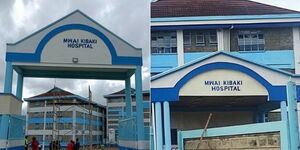As torrential rains continue to pummel Nairobi Metropolitan Areas and its environs, the real estate landscape in the capital is experiencing a stark divide, with some areas inundated by floods while others remain unscathed.
The deluge has not only exposed the vulnerability of certain neighbourhoods but has also unveiled discrepancies in rent prices across flooded and non-flooded zones.
Housing experts have long advocated for prospective tenants and buyers to inspect properties during the rainy season to gauge their resilience to flooding. The ongoing downpours since March have provided an opportune moment for such assessments.
In this analysis, we delve into Nairobi County's inundated areas, comparing their rental rates to those in drier locales.
Ideally, rent should consume no more than 30 per cent of a household's income, according to United Nations guidelines. With an average monthly income of Ksh60,000, Nairobi residents should be able to secure decent accommodation. However, the disparity in rent prices across income brackets is stark, with lower-income households typically confined to flood-prone areas where rents range from Ksh8,000 to Ksh30,000.
The Economic Survey 2017 delineates income groups, with lower-income households earning below Ksh23,670, middle-income households earning between Ksh23,671 and Ksh119,999, and upper-income households surpassing Ksh120,000. While affluent neighbourhoods like Runda command rents as high as Ksh200,000 to Ksh300,000 for a typical four-bedroom villa, low-income areas like Kasarani struggle with flooding and comparatively lower rents.
Among the popular areas in Nairobi County, a significant number have grappled with the devastating impacts of floods, drastically affecting rental prices and the lives of residents. Estates such as Roysambu, Kahawa Sukari, Imara Daima, and Buruburu, once sought after for their convenience and amenities, now face the daunting challenge of inundation.
In the Kasarani sub-county alone, areas like Gachieko, Giituamba, and Budalangi in Clay City have been submerged, with rents ranging from Kshs 8,000 to 20,000.
Similarly, in Makadara, the situation is dire, with locales like Cereal Board Village, Gakuyo area near Ngong River, and Jamaica feeling the brunt of the floods, impacting rental costs and displacing residents.
Nairobi County officials report a staggering 34 areas across nine sub-counties affected by the ongoing floods, with slum areas bearing the hardest hit. Sub-counties such as Westlands, Embakasi South, and Kibra have witnessed significant inundation, amplifying the plight of residents already grappling with socio-economic challenges.
In specific estates like NHC Nairobi West Estate, the recurring bursting of the Mutui-ini-Ngong River banks has caused massive flooding downstream, affecting Nairobi West and surrounding areas.
Imara Daima residents have faced the distressing sight of raw sewage flowing into their homes, prompting drastic measures like using buckets to drain away sewage in some instances.
The South C area has been nicknamed ‘South Sea’ due to submerged cars and houses, with reports of a school bus narrowly escaping being swept away by floodwaters.
Along Thika Road, near Clay Works, a swollen river flooded a section of the road, causing significant disruption to motorists and commuters.
Nyayo High Rise Estate in Mbagathi, despite its allure, remains flood-prone due to its proximity to a river, with several houses submerged after heavy rains breached the riverbanks.
Similarly, in Kileleshwa, residents of this upmarket suburb have faced recurrent flooding, with some resorting to unconventional methods like rowing boats from their flooded homes.
Even affluent neighbourhoods like Runda, known for their exclusive villas commanding rents of Kshs 200,000 to 300,000, have not been spared from the ravages of floods.
On April 24, the Kenya Red Cross stated, “Many parts of Nairobi experienced heavy rains overnight, resulting in flash floods in areas such as Mukuru, Mathare, Huruma, Ruaraka, Baba Dogo, Bosnia, Umoja 3, Choka, Njiru, Ruai, Utawala, Githurai, Kahawa, Eastern Bypass, Kinoo, Kijabe, Limuru, Ruiru, Graceland, Joska, Kaswito, Kicheko, Mangili, Kenyatta Road, Juja, Kitengela, and Magadi.”
Syokimau, Runda, and Athi River are among the affected neighbourhoods within the Nairobi Metropolitan Area (NMA), grappling with infrastructure damage and displacement.
The closure of major roads like the Thika Superhighway and Enterprise Road exacerbates congestion and impedes economic activities, pointing to the urgent need for resilient infrastructure and urban planning.
The majority of the estates in Spring Valley, Lang'ata, Upper Hill, Makadara, Imara Diama, and Westlands were unaffected by the flooding.
Some areas along Waiyaki Way include Kinoo, Kikuyu, Westlands, Mountain View, and Kabete. Jamhuri, Komarock, Woodley, Kitusuru, and Loresho were all unaffected.
Others, such as Ong'ata Rongai and Ng'ong on the outskirts of Nairobi, were unaffected.












